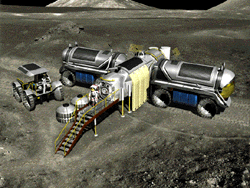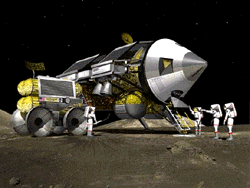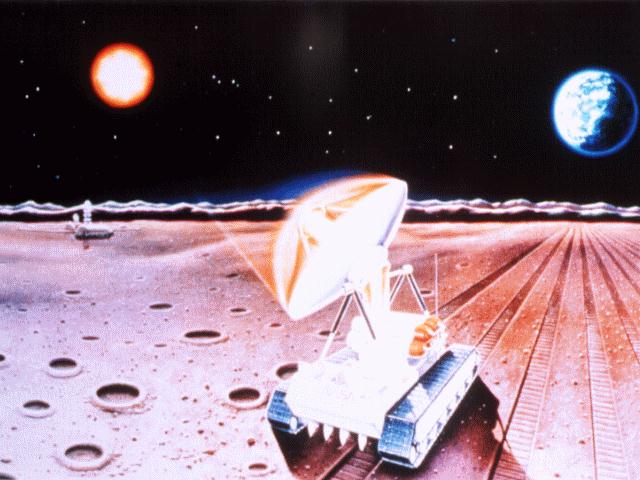
http://www.sciam.com/explorations/1998/0316moon/lunox.html
Image: John Frassanito and Associates for Johnson Space Center

With Lunar Prospector and the confirmation of ice
located at the Moonís north and south poles, NASA has had to upset its
future plans for manned missions to the Moon. If the water can be extracted
from the Lunar regolith it will significantly cut the cost of establishing
lunar bases on the moon. The water can be used to make fuel for spacecraft
that might travel from the Earth to the Moon and could also cut costs by
a factor of ten; making fuel available for voyages to Mars could reduce
the cost in half (Scientific American Inc, 1998). Humans must have water
in order to survive the harsh environment of the Moon and space exploration.
Prospector has proven that the Moon is not a dry barren sphere that orbits
the Earth as previous Apollo studies had established, but it may have turned
this frozen lunar soil into the most important piece of real estate in
the solar system (Scientific American Inc, 1998). Water is the most important
ingredient for life, but it can also be broken down into its elements:
"Hydrogen and oxygen." These elements can be used to make breathable air,
electricity, power, and to fuel rockets.
One of the problems of high cost was having to ship
water from the Earth to the Moon. At this time it cost about 10,000 dollars
to ship one pound of material into space but NASA is researching ideas
to cut the cost by a factor of 10 to 1,000 dollars per pound (Scientific
American Inc, 1998).. Even with the lower cost and recycling, it still
would cost trillions of dollars to ship water to permanent bases (Scientific
American Inc, 1998). It has been calculated by NASA that an area of frozen
lunar soil the size of a football field can generate enough water for drinking,
bathing and washing and food preparation for up to a six member crew for
over a year (Scientific American Inc., March 16, 1998). The power generated
can produce 100 megawatts electricity for an entire year and yield rocket
propellant to carry two crews of four people from the Earth to the moon
for up to a year.
At any rate the latest developments have caused
NASA to change or alter mission plans. One such plan is called LUNOX for
"Lunar Oxygen." The idea was to extract oxygen from the lunar soil by heating
it to a molten state and this process had sprung plans to use the leftover
remains to make bricks to build future colonies (Scientific American Inc.,
1998). Although the news of water already on the moon would make the technology
useless the plans of the mission it self could be useful when establishing
a base on the moon. The images below were prepared by NASA to describe
the LUNOX mission. The only difference now between this scenario and what
will happen is that scientists have a far less costly plan to split water
into hydrogen and oxygen by electrolysis, which uses an electrical current
to break up water molecules.



http://www.sciam.com/explorations/1998/0316moon/lunox.html
Image: John Frassanito and Associates for Johnson Space
Center

http://www.sciam.com/explorations/1998/0316moon/lunox.html
Image: John Frassanito and Associates for Johnson Space
Center

http://www.sciam.com/explorations/1998/0316moon/lunox.html
Image: John Frassanito and Associates for Johnson Space
Center

http://www.sciam.com/explorations/1998/0316moon/lunox.html
Image: John Frassanito and Associates for Johnson Space
Center

http://www.sciam.com/explorations/1998/0316moon/lunox.html
Image: John Frassanito and Associates for Johnson Space
Center

http://www.sciam.com/explorations/1998/0316moon/lunox.html
Image: John Frassanito and Associates for Johnson Space
Center

In order to establish a permanent community on the
moon, we have to be able to utilize the resources available. The real test
of a programs success is whether people stay or not. In order for this
to happen people need to be able to extract and use local resources to
make their settlements permanent. If we are unsuccessful we would have
to ship everything from the Earth and that would become to expensive and
cumbersome, and these settlements would be deserted. Of course the market
will dictate what products the settlement will produce. First we will need
to send robotic units ahead of crews to do important experiments and follow
that with engineering prototypes to demonstrate and verify the technology
and products.
We know from past explorations and examination that the lunar
material, soil, and rock compositions of the moon contain chemically bound
oxygen which adds up to approximately 45% of the weight of lunar rocks
and soil (Scientific American Inc, 1998). These materials are also made
up of silicon, iron, calcium, aluminum, magnesium, and titanium which can
be extracted as metals; quite possibly as by product of extracting oxygen.
Lunar soils have trapped a number of different kinds of particles from
solar wind over billions of years and contain helium, hydrogen, nitrogen,
and carbon from the Sun. These elements can be heated into a gas and be
extracted, along with other light gases, we can extract an non-radioactive
isotope of Helium-3 (He-3) from the lunar soil (Scientific American Inc,
1998). He-3 can be used for fusion reactors here on Earth and promises
to be a much cleaner than fission-based plants using uranium. The U.S.,
European, and Japanese fusion research scientists are currently working
on He-3 as a primary fuel of a clean nuclear fusion reactor (Lunar Institute
of Technology, 1998).
4. Future Missions
Now that the moon is considered a valuable piece
of real-estate its resources are sure to spark intense political debate
by over the way the lunar resources are used. During the next few years
a number of nations will send unmanned spacecraft to the moon in an effort
to establish permanent facilities and observatories. By 1999, the Japanese
will send a seismic probe called Lunar-A
(Scientific American Inc, 1998). It will image the surface of the moon
and send down three "penetrators," which are designed to plunge into the
Moonís surface. The penetrators have seismometers to monitor moon quake
activity over the next year and produce 3-D images of the Moonís interior.
It will also carry a device to measure heat flow through the lunar soil.
In 2002, the European Space Agency (ESA), will land a robotic rover (Scientific
American Inc, 1998). The project known as (LEDA) which stands for Lunar
European Demonstration Approach, will carry a soil-processing test facility
and will collect samples with its robotic arm. It will be equipped with
a drill where it could possibly extract water from the south
polar region on the Moon (Scientific American Inc, 1998). The Lunar
Orbiting Observatory Mission (LOOM), has been scheduled to embark on its
mission in 2002 by Japan. Its mission is to map the entire lunar surface
which will take two or three years and a probe will be landed to demonstrate
landing technology (Scientific American Inc, 1998). Finally, the Japanese
will send into lunar orbit Selene 1. It will be carrying 15 instruments
including a radar sounder, laser altimeter, X-ray flourescence spectrometer
and gamma-ray spectrometer to study the origin, evolution, and tectonics
of the Moon (Scientific American Inc, 1998). Following its year long orbit
the orbiter will touch down on the lunar surface for two months of operations.
5. Conclusion
I believe the future of Moon looks bright. With
continued collective efforts from all nations, we can hope to establish
permanent lunar bases and colonies on the Moon. Developing the lunar resources
is also very important to humanity living and working on the Moon. Still,
much more research is needed before we have domes of inhabitants extracting
water from the soil below. Exploration of the lunar surface in search of
oxygen-rich soil, hydrogen, helium-3, and water, has to be a major priority
for NASA. What worries me is with these resources available for the taking
is it may be as alluring as the wild frontier. There might be a rush of
people trying to develop and mine the Moon, hoping to reap the rewards
for them personally. Hopefully there can be a moon
treaty devoted especially to the development of the Moonís resources
signed by all nations but Iím sure there are going to be some private interest
groups that will want a piece of the action. In reality, we are still some
time away from human habitation on the moon, so donít sell your house yet.
The question is not if, but when these visions will become reality and
with the confirmation of ice on the Moon it will surely speed up the time
table.